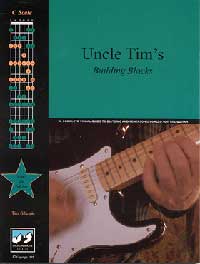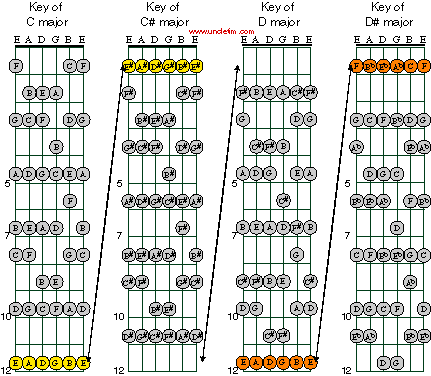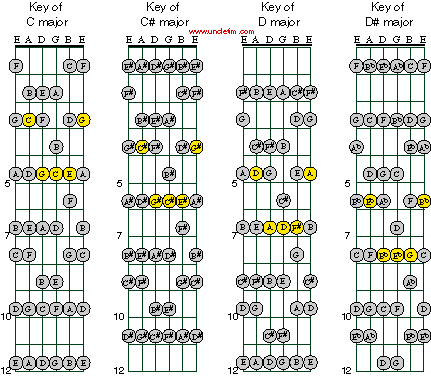

By Tim Gillespie
Learn how to solo once and for all!
Soloing is like learning to talk. Knowing the words in not enough. You have to be able to form phrases in the key and then transform them into statements. There is no time to read music notation or learn where the notes are when forming a solo. You have to show up with this information already in place. Building Blocks will show you this using images because once you have the image in your head, you know exactly where to go and you can do it on the spot.
There is nothing like it and nothing can make up for it. For $20, you can put this all to rest right now. Pick up a copy today.
eBooks are delivered instantly!
How The Diatonic Signature Works.
Somewhere around 15 years ago, I asked myself the question, what am I thinking about when I solo? It made me contemplate what was running through my head when I was actually creating a secondary part. Anyone who plays lead guitar or improvises on a regular basis knows how precious little time there is to think about anything. Yet at the same time your brain needs to supply some direction to your fingers. If this works out all right, you might hear a nice line or a complete lead.
So with very little time to use to provide guidance, how can you actually get the job done? And how it is that some guitarists can glide through it as if they know where they are and what they want to say with little or no problem? What is going through their head when they solo?
When I asked myself these questions, the concept of my first book became apparent. I called it Uncle Tim's Building Blocks. I chose this name because it identifies the basic building blocks of scales and lead guitar. These building blocks are the mental pictures that run through my mind when I improvise and solo, and that is what we are going to talk about today.
In case you think this may be a subtle ploy to advance one of my books, it is. I don't know how to write about this very important concept without doing so. That said, with this column you should be able to study this incredibly important information without me or my work. Truly I offer this information as a gift. This is a gift that can propel you far beyond the mysteries of the fretboard and most of the guitarists you will ever meet, as long as you do one thing! Practice it! It's one thing to know it, it's quite another to do it. You must practice this or it will be just another idea that might have made the difference. So let's go.
On the neck of a guitar there is one pattern of notes that contains 100% of every key! Every scale, every chord, every note! No matter what you want to look for inside a key, it is contained in this pattern. Have you ever found yourself wondering about some musical concepts and how they work? Wondering if there is some way to understand the madness of descriptions of music for a guitar? I hear comments all the time from people that describe something that is so hard to understand, I have to decode it to figure out the meaning. Historically we have discussed musical concepts in terms of a musical staff and relative relationships that are not at all obvious. We describe chords this way, as in drop the third to create a minor chord. If you don't understand that a major chord is inferred and know how it is constructed, you probably don't understand this. And we describe scales this way too. 1, b3, 4, 5 b6, the Blues Pentatonic scale.
If I have to decipher lingo like this in a jam session, it is almost guaranteed to bring things to a grinding halt. Too much time is spent on understanding and turning that understanding into motion and then sound. When I solo, there are a myriad of thoughts occurring. My thoughts range from hitting the string correctly, to what area of the fretboard I want to play in, to changing my modulation to maximize my sympathetic response to the chords being played. This stuff happens in micro seconds. And for the most part it all has to take its proper place for my style to show up. These are the basics to how I do it.

Anyone who has looked around my web site has seen this graphic. The graphic to the left is the twelve fret signature for the key of C. This pattern contains 100% of everything found in any diatonic key. 100% of it! This is important because if you want to understand anything found in a key, all you have to do is examine this graphic! It really is all here. Test it! Think of anything diatonic and then see if you can find it in here. It is here. The only question is, can you find it?
By the way, this signature of notes repeats every twelve frets. Look at the graphic to the right. The exact same pattern repeats at the twelfth fret (the white dots). If you want to find any scale in the keys of C major and A minor natural, it is here. This can be a mysterious set of concepts to deal with. One of the most common statements I hear is, "I didn't know the scale of C covered the whole fretboard". Many people learn a scale fragment and think that is the entire scale for the key. In fact, they are playing a small subset of the entire scale.
The nice thing about studying the entire signature is, it is much easier
to understand. If you are dealing with only a small fragment, it can take
a lot longer to understand the information and fit it  in with everything
else. It's disconnected from the entire body of key based information.
One other thing, this should be as easy as looking at dots. Any concept
can be displayed as dots with notes in them. After a while you learn all
the notes because you get accustomed to seeing the dots and thinking about
your fretboard.
in with everything
else. It's disconnected from the entire body of key based information.
One other thing, this should be as easy as looking at dots. Any concept
can be displayed as dots with notes in them. After a while you learn all
the notes because you get accustomed to seeing the dots and thinking about
your fretboard.
In past columns I have broken this signature into smaller fragments. Each fragment sits right next to the others and in most cases borrows a few notes from the others. Remember scales are played in alphabetical order. You start on a note, often times the keynote of the scale, and you proceed up one of the pathways. After a few octaves there is usually a convenient note to stop the forward progression and start to reverse your order until you arrive back at the first note. This is the usual way we learn scales. One of the problems with this approach is if you don't continue to learn you never assemble the entire picture. You are always dealing with pieces and you assemble the picture in your head and then transfer that knowledge to the fretboard. When people that learn this way are asked to continue the scale down past the stopping note, they often say, I didn't know you could. If you deal with the picture from the beginning, you eliminate one very big and time consuming step. All you have to do is look and transfer the information to your fingers.
Is this easier? O yeah! But this also infers you are intimate with the scale. When you are playing a lead, there is no time to try to learn the scale. You have to know it and know it cold. Why is this important? A lead line must be crafted. It involves using information in a creative way. If you are fumbling with the mechanics, you will not have enough time to think of creative ways to mingle the notes and you will not be able to execute the necessary moves. It will show up right away and everyone will notice it. You have to know it and it is better to know it cold. Then you can focus on interpreting the music and adding a spontaneous part.
So practicing this information before you need it, is critical. It's the same approach used in business school today with writing papers. I remember a fellow student commenting on why we had to write so many papers. The instructor replied, "to prepare you for the business world. You will have to write a lot of papers when you get a real job. When you graduate you will already know how to do it, then you can focus on the content."
This is true with music too. You must prepare or you will not be ready. If you want to play lead guitar, it pays to be familiar with the playground. It will show up in your music.
So now we have looked at the scales in the key of C major and A minor. If you want to practice these individual fragments, back issues of this newsletter have several of them.
But remember, I said that every piece of diatonic information is present in this signature of notes. It is! Every key uses this exact information to create the key. So how does it work? Easy, you just move the pattern of notes.
 This is
how you apply the diatonic signature for every key. Notice this is a chromatic
example. We are proceeding by moving one fret for each example. C# is
one fret from C.
This is
how you apply the diatonic signature for every key. Notice this is a chromatic
example. We are proceeding by moving one fret for each example. C# is
one fret from C.
Notice that each key uses the exact same pattern, the only difference is the pattern is moved down one fret. Look at the yellow notes in the first example. Notice when you position the pattern for C#, those same notes now show up one fret lower. The notes that were on fret one for C major are now on fret two for C# major. Then the entire pattern flows. Just look at the pattern of dots, forget about the actual notes for a minute.
The same thing happens in the next examples. The pattern is moved one fret down for each key. Spend as much time on this as you need. This is absolutely critical that you understand this. Everything else is tied to this.
 Have you ever
played a barre chord and then moved it up a few frets to form a new chord?
Have you ever
played a barre chord and then moved it up a few frets to form a new chord?
This shape will be used in this next example. This is a common barre chord that is capable of becoming any major chord.

 So
in this example, I am illustrating how not only the scales are here but
so are the chords. This chord form is an example of the tonic chord in
each example. In the first example this is a C major chord. In the C#
example, the chord becomes a C# major. Same for the keys of D and D#.
So
in this example, I am illustrating how not only the scales are here but
so are the chords. This chord form is an example of the tonic chord in
each example. In the first example this is a C major chord. In the C#
example, the chord becomes a C# major. Same for the keys of D and D#.
Now at this point we are starting to explore and explain some complicated concepts. It is here that I strongly suggest you start to work through some of this if you have not done so already.
I am showing one chord that flows through all these keys. I am inferring all the other chords in the key will do the same thing. They will! These are very big concepts and it takes time to get a grip on this.
The past issues will shed a great deal of light on this as well. Check back to see how triads fit in as well as chords. There are scale examples that will get you started playing linear streams of notes inside the signature. There are triad examples that you can use to engage basic chord forms.
The idea is to start to take ownership with this and see how things work inside. Develop your own questions and then answer them. Once you become familiar with this you should be able to start to see all sorts of relationships inside. This will only get easier.
This method of looking at the guitar can provide a rock solid way of examining the fretboard and keys. It will help you to understand the approach used in different books. You will be able to see entire songs carved right out of this amazing signature of notes. You can also learn how artists violate keys and maintain creativity.
I call this the grand unification principle for the guitar because every time someone shows you a snippet of a scale or a couple of chords you can place them inside this framework and put them in context with the big picture. Examining small subsets is as easy as limiting your thoughts to a small part of this signature. If you play in diatonic keys most of the time, you now have the opportunity to know it all. If you are trying to play "out of the box" you have to understand "the box" to be able to escape it.
If you are more interested in less used signatures like the Blues or a Blues pentatonic framework, you will be happy to know they all contain their own signature and once studied and understood like this, you have command of the entire structure of whatever signature you are working in. Difficult material becomes easy. Very easy.
With this method, you can identify and concentrate on whatever part of
a key interests you. With a few weeks work, you can start to expand what
you know by an order of magnitude. Signatures explain everything!